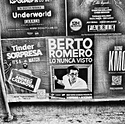Best to make clear from the beginning: This is not a critical Post, I'm only curios!
It was said somewhere in the beginning that Ferrania was one of only few that was completely self-sufficient beqause that was Mussolinis order.
My question is: What was _Not_ saved and what didn't exist at all?
We know that the machines for production of base material, chemicals, "Little Boy" and packaging exists.
My guess that a paper mill for making backing paper and machines to make cassettes is missing. Does the extrusions dies (???) for for the different cassettes exists?
Anything else??
/Johan
There was a lot of stuff sold off before we ever came on the scene - much of it while Ferrania was still technically operating. Some of it when 3M changed the company to Imation (briefly) - and some of it just before we arrived.
But to my knowledge, 99% of the equipment necessary for our eventual self-containment is in our warehouse right now. There are a few things that would have been
nice to have that were gone by the time we arrived - but nothing that was 100% essential.
We would not have moved forward with this crazy project otherwise. It would have been, for all practical purposes, impossible to achieve our goals without having everything we need up front.
If we
do discover a need for something that we don't have in storage, we can commission it to be built. We have detailed schematics, drawings, CAD files, specs, and/or supplier information. The archives we inherited are a real gold mine and we've just barely scraped the surface.
A lot of this information is on paper, but we also have thousands of punch-cards, miles of microfilm, and thousands of floppy disks and hard drives (these have already been offloaded into a modern server).
One of the major undertakings of the next few years will be to collate, categorize and digitize this information into a modern database with a proper taxonomy and schema to make it simple to access.
But as Nicola told me recently, anything we eventually need that we don't currently have, we will need because we are much more successful than our current 5-year estimates show.
This is, of course, a problem that would be good to have...
To answer your specific questions:
We do have
most of one paper coating line, but it needs a lot of work. Adapting it to make backing paper is the idea - but that's on the "way down the road" list.
We have found a source for the near term - we just need to do some actual testing once the 120 machines are up and running.
We are on the lookout for a rotary drum printer to print the backing paper. If anyone sees one up for sale, let me know...
We have two automated cassette-making machines. One is integrated into our 35mm line, and one is a stand-alone machine that will likely be saved for parts.
We also have a couple of manually operated forming machines. One that wraps the plates around the cores and another that pressure-fits the caps. There is also a station for applying the felt - by hand(!)
Nicola sent me a great video from the 60s of three workers cranking out hundreds of cassettes per hour with these worktable/machines.
We don't have the extrusion machines or dies for manufacturing the raw components of 35mm cassettes, but we do have blueprints, specs and everything we need to re-create these things if necessary.
For now, we can simply purchase the tin plates, pre-printed from a local supplier and we can buy the cores and caps from one of Ferrania's former suppliers.
We can of course go to our archives and pull the blueprints for any molds or dies we need - even if the process of getting the molds/dies just right can be a bit pricey.
For the short term, we can buy-in what we need with no problem.
We're also closely watching 3D printing tech. Making industrial components has gone from being a total fantasy to being perfectly feasible (although still very expensive) in just the past 5 years.
At the rate the tech is improving and prices are dropping, we could simply print all the components we need (especially plastics) on demand within in another 2 or 3 years - and probably do it at a cost comparable to buying them in.






 etc.
etc.